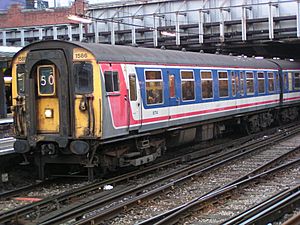British Rail Class 411 facts for kids
Quick facts for kids British Rail Class 411 |
|
|---|---|

Class 411 4 Cep no. 1586, about to depart London Victoria on 18th March 2003, with a service to Ramsgate. This train was painted in the old Network SouthEast colours and was run by Connex South Eastern. This was its last journey before it was taken out of service and later scrapped.
|
|
| In service | 1956-2005 |
| Manufacturer | BR Eastleigh |
| Number built | 135 trainsets |
| Formation | power car + 2 trailer cars + power car |
| Operator(s) | British Rail, South West Trains, Connex South Central, South Eastern |
| Specifications | |
| Car length | 265ft 8 1/2in |
| Width | 9 ft 3 in (2.81m) |
| Height | 12 ft 6 in (3.81m) |
| Maximum speed | 90mph (145 km/h) |
| Weight | Total - 159.4 tonnes |
| Power output | 4 x 250 hp traction motors total 1,000 hp (746kW) |
| Electric system(s) | 750V dc third rail |
The British Rail Class 411 was a special type of electric train. It was also known as the 4 Cep. These trains were built in a factory called Eastleigh between 1956 and 1963. They were made for the new electric train lines in Kent, a county in England.
These trains were designed based on an older train model. It was called the 4Cor and was built in 1937 by the Southern Railway.
Contents
What is an Electric Multiple Unit?
An Electric Multiple Unit (often called an EMU) is a type of train. It gets its power from electricity. Unlike some trains, an EMU has its own engines built into the carriages. This means it doesn't need a separate locomotive to pull it.
EMUs are great because they can accelerate quickly. They are also quieter and produce no pollution at the point of use. The Class 411 trains used a "third rail" system to get their electricity. This means they picked up power from an extra rail alongside the tracks.
Building the Class 411 Trains
The Class 411 trains were built by British Rail at their Eastleigh works. This was a busy time for train building in the UK. A total of 135 train sets were made. Each set usually had four carriages linked together.
The first trains were ready in 1956. They were designed to handle the growing number of passengers. These new electric lines made travel faster and more modern.
Life of the 4 Cep Trains
The Class 411 trains served for a very long time. They were in service from 1956 all the way until 2005. That's almost 50 years of carrying passengers!
Where Did They Run?
Most of their life, these trains ran on lines in Kent. They connected places like London Victoria to towns along the coast. Over the years, different train companies operated them. These included British Rail, South West Trains, Connex South Central, and South Eastern.
How Fast and Powerful Were They?
These trains could reach a top speed of 90 miles per hour (145 km/h). Each train had four powerful motors. Together, these motors produced 1,000 horsepower. This was enough power to move the train, which weighed about 159.4 tonnes.
End of an Era
By the early 2000s, the Class 411 trains were getting old. Newer, more modern trains were being built. So, the 4 Cep trains were slowly taken out of service. The last one was withdrawn in 2005. Many of them were scrapped, meaning they were taken apart for their materials.
The Class 411 trains played an important role in British railway history. They helped modernize train travel in the south-east of England for many decades.

